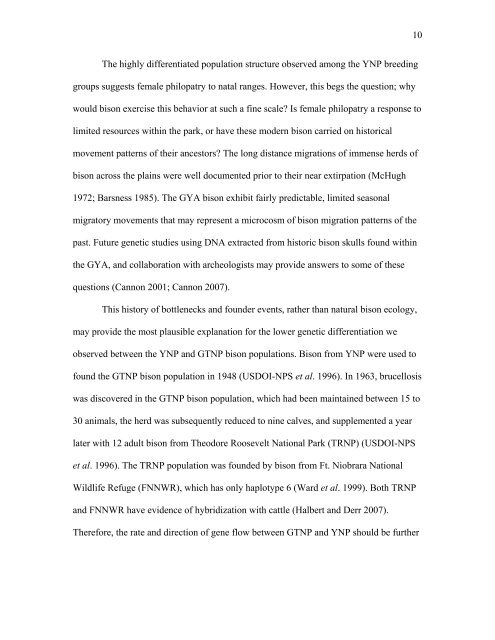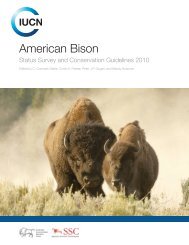Declaration Dr. Thomas H. Pringle - Buffalo Field Campaign
Declaration Dr. Thomas H. Pringle - Buffalo Field Campaign
Declaration Dr. Thomas H. Pringle - Buffalo Field Campaign
You also want an ePaper? Increase the reach of your titles
YUMPU automatically turns print PDFs into web optimized ePapers that Google loves.
The highly differentiated population structure observed among the YNP breeding<br />
groups suggests female philopatry to natal ranges. However, this begs the question; why<br />
would bison exercise this behavior at such a fine scale? Is female philopatry a response to<br />
limited resources within the park, or have these modern bison carried on historical<br />
movement patterns of their ancestors? The long distance migrations of immense herds of<br />
bison across the plains were well documented prior to their near extirpation (McHugh<br />
1972; Barsness 1985). The GYA bison exhibit fairly predictable, limited seasonal<br />
migratory movements that may represent a microcosm of bison migration patterns of the<br />
past. Future genetic studies using DNA extracted from historic bison skulls found within<br />
the GYA, and collaboration with archeologists may provide answers to some of these<br />
questions (Cannon 2001; Cannon 2007).<br />
This history of bottlenecks and founder events, rather than natural bison ecology,<br />
may provide the most plausible explanation for the lower genetic differentiation we<br />
observed between the YNP and GTNP bison populations. Bison from YNP were used to<br />
found the GTNP bison population in 1948 (USDOI-NPS et al. 1996). In 1963, brucellosis<br />
was discovered in the GTNP bison population, which had been maintained between 15 to<br />
30 animals, the herd was subsequently reduced to nine calves, and supplemented a year<br />
later with 12 adult bison from Theodore Roosevelt National Park (TRNP) (USDOI-NPS<br />
et al. 1996). The TRNP population was founded by bison from Ft. Niobrara National<br />
Wildlife Refuge (FNNWR), which has only haplotype 6 (Ward et al. 1999). Both TRNP<br />
and FNNWR have evidence of hybridization with cattle (Halbert and Derr 2007).<br />
Therefore, the rate and direction of gene flow between GTNP and YNP should be further<br />
10










